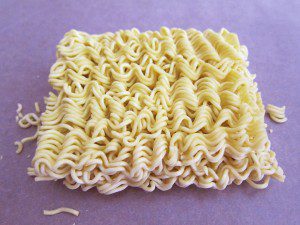By Natasha Longo
Ramen noodles contain Tertiary-butyl hydroquinone (TBHQ), which is a by-product of the petroleum industry and food additive frequently used to preserve cheap processed foods. It is one of those chemicals that is neither digestible or beneficial in any way for your body.
A gastrointestinal specialist conducted an experiment with a time lapse video inside the stomach, comparing both fresh and preserved ramen noodles. After two hours of digestion, the results were staggering.
The first-of-its-kind experiment by Dr. Braden Kuo of Massachusetts General Hospital wanted to find out exactly what happens to food in the stomach and digestive tract after consuming ramen noodles.
Thanks to the “smart pill”, a camera the size of a multi-vitamin, Dr. Kuo could do his experiment, showing what happens in the gut of someone who ate a package of instant ramen noodles compared to fresh.
Dr. Kuo recorded 32 hours from the pill camera.
“What we’re seeing here is a stomach contracting back and forth as it’s trying to grind up the ramen noodles,” Dr. Kuo says of the beginning of the video.
For comparison, the study volunteers also ate fresh, homemade ramen noodles on a different day.
The video at 20 minutes, and 2 hours, shows a striking difference.
“The most striking thing about our experiment when you looked at a time interval, say in one or two hours, we noticed a processed ramen noodles were less broken down that homemade ramen noodles”, noted Dr. Kuo.
This affects nutrient absorption and could theoretically allow preservatives to linger longer periods in the stomach cavity before being transported to the intestines and subsequently eliminated.
What Is TBHQ?
In processed foods, TBHQ is sprayed on the food or on its packaging to prevent discoloration and changes to flavor and odor. Others products, such as cosmetics, perfumes, varnishes and lacquers, contain TBHQ to maintain stability.
Small amounts of TBHQ may not kill you (although death has occurred) or even make you feel immediately sick, but it can have a long term effect on your health such as weakening of organs and contributing to the onset of cancers and tumors.
The FDA says that TBHQ must not exceed 0.02 percent of its oil and fat content. Death has occurred from the ingestion of as little as 5 grams. This would be a considerably high dose compared to the amounts found in foods, but it gives us a good indication on the toxicity level of this preservative.
At higher doses, it has some negative health effects on lab animals, such as producing precursors to stomach tumors and damage to DNA. A number of studies have shown that prolonged exposure to high doses of TBHQ may be carcinogenic, especially for stomach tumors.
Ingestion of a single gram (a thirtieth of an ounce) has caused nausea, vomiting, anaphylactic shock, diarrhea, ringing in the ears, delirium, a sense of suffocation, and collapse. Some people have reported having anxiety and night terrors and asthma after ingesting TBHQ. Others have reported having a body rash and swollen lymph nodes.
You can find TBHQ in McDonald’s chicken McNuggets across the United States, however McDonalds European chicken nuggets do not contain the toxic preservative. This is interesting since both the European Food Safety Authority (EFSA) and the FDA have evaluated TBHQ and determined that it is safe to consume at the concentration allowed in foods. The EFSA considers TBHQ to be non-carcinogenic, so why do they not allow it in chicken mcnuggets?
Other Food Products Containing TBHQ:
- McDonalds chicken nuggets and french fries
- CHEEZ-IT Crackers made by Kelloggs
- Butterfinger chocolate and Reese’s Peanut butter cups
- Nestle Crunch
- Wheat Thins
- Microwave popcorn
- Pam cooking spray
- Aldi products
- Keebler Club crackers
- Kellogs eggo frozen waffles and many other kellog products
- Taco bell beans and some taco shells
- Teddy Grahams
- Red Barron frozen pizza
- Keebler Cookies
- TastyKake
- Little Debbie
- Kellog’s Pop-Tarts
- Homestyle Peanut butter cookies
- Some forms of soymilk
- Different breads, cereals and crackers could contain TBHQ
- Crisco oil
- Some pet foods
- Many cosmetic products and baby products
- Some hair dyes lipsticks and eyeshadows
- Wrigley’s gum
- Little Debbies nutty bars and some M&M products
- KFC beans and fried chicken
There are many more processed foods not listed above which contain TBHQ. A conclusion that is now quickly reaching vast numbers is that all processed food in general, has far too many problems to be considered safe. Our regulatory agencies are not responsibly working to resolve these problems, and instead of removing these toxins from the food supply are claiming that safe levels exist.
Since when did safe levels exist of any poison entering the body?
Article sources:
oregonstate.edu
Previous article by Natasha:
8 Healthy Foods That Can Easily Replace Their Less Healthy Counterparts
About the author
Natasha Longo has a master’s degree in nutrition and is a certified fitness and nutritional counselor. She has consulted on public health policy and procurement in Canada, Australia, Spain, Ireland, England, and Germany.
This article was reposted with the permission of the kind crew at preventdisease.com
Amethyst, a revered stone in Taoist practices, is known for its powerful ability to absorb harmful energies and restore balance to the body, mind, and spirit. This crystal acts as an energetic filter, helping clear negative energies in your environment and body and promoting peace, clarity, and emotional stability. Join this free online event to learn how Taoist stone medicine uses amethyst to purify and uplift your life.
During this event, you’ll learn the ancient practice of creating a diamond-shaped amethyst purification grid designed to clear harmful energy and bring fresh, positive vibrations into your space. You’ll also discover how amethyst and other stones can cleanse your surroundings and promote spiritual renewal, providing clarity and peace in your life.
Don’t miss out on this unique opportunity to learn the healing powers of amethyst and Taoist stone medicine. Register for the free event today to learn practical techniques to transform your environment and enhance your well-being. Join us now to unlock the power of amethyst!
If you’ve found value in our articles, we invite you to support the release of our brand-new book, “Gratitude Practices for Kids: A Practical Guide for Adults to Instill a Spirit of Appreciation and Positivity in the Next Generation.“
“Gratitude Practices for Kids” brings together over 25 innovative and accessible practices designed to enhance gratitude in everyday life. This comprehensive guide is backed by 17 scientific studies, ensuring each concept is grounded in research, underscoring our commitment to nurturing growth, emotional intelligence, and positive interactions between adults and children.
We encourage you to opt for the paperback version to celebrate this new release. Dive into its fresh pages away from digital distractions, allowing you to immerse yourself in the transformative practices it offers.
Over recent years, Wake Up World has faced significant online censorship, which has impacted our financial ability to operate. Moving into book publishing represents a strategic step to secure the ongoing funds needed to continue our mission. By purchasing Gratitude for Kids, you help us keep our content free and accessible to everyone, avoiding needing a paywall. With over 8,500 articles published in the last 13 years, we remain dedicated to keeping our valuable content open to all.









